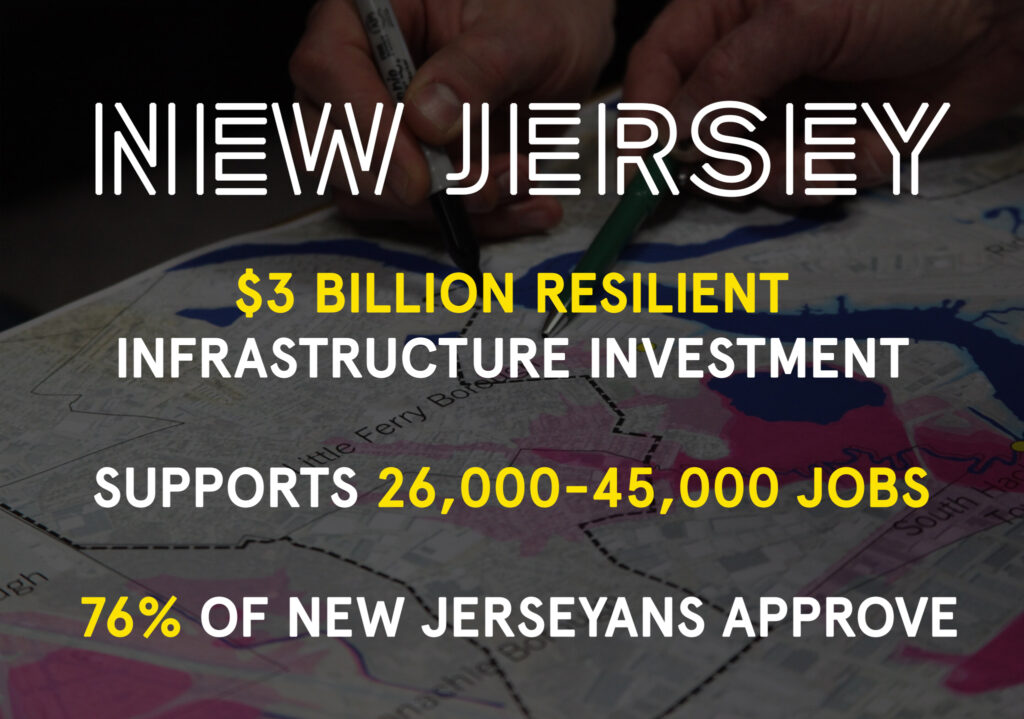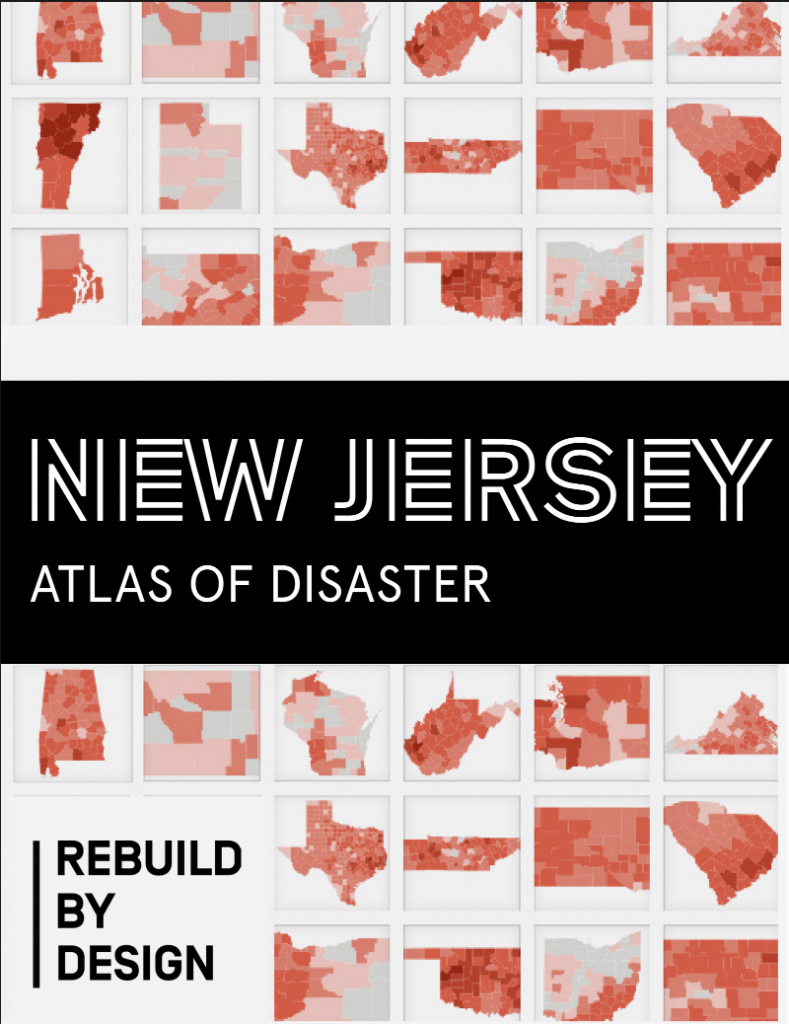
NEW JERSEY CANNOT WAIT ANY LONGER
Between 2011 and 2024, New Jersey experienced 14 federally-declared climate disasters, with every one of the state’s 21 counties facing at least five disaster declarations. Hurricanes, extreme rainfall, heat waves, and drought have already cost U.S. taxpayers more than $7.9 billion in New Jersey, ranking the state fifth in the nation for per capita disaster spending. Despite these mounting costs, New Jersey still lacks a dedicated source of funding to prepare every community for the challenges ahead.
Rebuild by Design has released a series of groundbreaking reports that demonstrate both the urgency and the opportunity for action. Our research shows how investment in resilience can support thousands of good-paying jobs, highlights strong voter support for a statewide funding mechanism, and examines the risks of climate-driven displacement. Together, these findings make clear that New Jersey can no longer afford to delay, and that solutions are within reach.
To secure a livable future, New Jersey must establish sustainable, long-term funding for climate adaptation infrastructure. Residents are calling for proactive, comprehensive strategies to ensure that the next storm does not bring even greater destruction. While local planning is underway in many municipalities, reliable funding has yet to follow. A dedicated state-level funding source could bridge this gap. Our proposals include:
#1 Statewide Ballot Measure
Voters around the country have overwhelmingly supported funding infrastructure measures that address resilience and other climate-related investments. A campaign to pass a Resilient Infrastructure Bond would foster a public conversation with voters about prioritizing flood infrastructure while galvanizing the support needed to justify this type of infrastructure spending.
#2 Insurance Surcharge
Rebuild by Design modeled a modest 2% surcharge on certain lines of property and casualty insurance, excluding workers’ compensation and medical malpractice, and found that, in New Jersey, the surcharge could support $9.1 billion in climate infrastructure investments over 10 years.
Scroll below to explore our research and proposals for how New Jersey can move forward, from a statewide ballot measure to a modest insurance surcharge, to protect communities, strengthen our economy, and build a more resilient future.
NJ FEMA OBLIGATIONS DATA TABLE (2011-2024)
Explore our New Jersey County Overview chart to see how New Jersey counties are experiencing and responding to extreme weather.
From 2011–2024, New Jersey experienced 14 different statewide disasters. Morris County itsself declared nine disasters, the highest in the state. Bergen County led in disaster response spending with over $386 million. Monmouth and Middlesex Counties also invested heavily in both response and mitigation, showing the ongoing financial and community impacts of extreme weather.
The FEMA Total is calculated by adding county funds from FEMA Public Assistance (PA), which repairs damaged infrastructure, and FEMA Hazard Mitigation (HM), used to reduce future risks. Use this chart from the NJ Atlas of Disaster, or the Atlas of Accountability interactive map below, to compare counties, explore patterns of risk and investment, and see where resilience efforts are most urgently needed.
GET INVOLVED
JOIN THE MOVEMENT
Rebuild by Design is working to secure dedicated funding for climate infrastructure, empowering all New Jersey communities to invest in resilience today. We are seeking organizations, community leaders, and dedicated advocates who can play an active role in advancing climate resilience efforts across the state. Your support is critical in securing the funding and policies that will protect New Jersey’s communities and infrastructure for the future. Join now >>
NEW JERSEY EVENTS
Join Rebuild by Design for our New Jersey speaker series, offering an in-depth look at the updated findings from the NJ Atlas of Disaster, along with insights from guest speakers who are leading efforts to address climate challenges in New Jersey. View events >>
OUR RESEARCH
Read our Atlas of Disaster, Flood Risk = Financial Risk NJ, Understanding the Potential Economic Impacts of Climate Resilience Investment Scenarios in New Jersey, and more. Rebuild by Design’s collaborative research and design approach is heavily rooted in understanding issues from multiple perspectives. By bringing together outside talent and local experts, Rebuild connects big picture problems with replicable solutions that can be embraced by communities and governments alike.
Poll Finds 3 in 4 New Jerseyans Worried About Damage from Extreme Weather

Rebuild by Design and Environmental Defense Fund worked with Fairleigh Dickinson University through StimSight Research, to better understand how New Jersey voters view climate impacts and resilience. The results show widespread concern about flooding and extreme weather, and strong support for proactive state action, including major investments to reduce the risk for communities and infrastructure.
According to the Fairleigh Dickinson University poll, 66 percent of voters believe the state government should be doing more to address damage from extreme weather events, with majorities across party lines in agreement. Support extends to large-scale solutions: more than three-quarters of voters back a $3 billion bond to fund resilience projects that would help safeguard homes, businesses, and infrastructure. These findings demonstrate that New Jerseyans recognize both the risks of inaction and the long-term benefits of investing in resilience.
$3 Billion Climate Resilience Bond CAN Support 26,000+ Jobs IN NJ
The report, Understanding the Potential Economic Impacts of Climate Resilience Investment Scenarios in New Jersey, researched by the infrastructure firm AECOM, in collaboration with Rebuild by Design, analyzes two funding scenarios as examples of how New Jersey can create a reliable source of state-level resilient infrastructure funding: $3 billion and $9 billion, in sectors such as construction, engineering, planning, environmental restoration, and long-term operations and maintenance.
The research models targeted investments across three categories:
- 40% for Flood Risk Reduction and Restoration
- 40% for Water Infrastructure
- 20% for Climate Resilience (e.g., urban cooling, community-scale adaptation, nature-based solutions)
As detailed in Table 1, the analysis estimated that a $3 billion investment scenario could support 26,000 jobs, and a $9 billion investment scenario could support 77,000 jobs across New Jersey. Should projects funded by such investments leverage additional funding from federal sources by providing local matches, a $3 billion investment scenario could support $2.2 billion in additional spending and 45,000 jobs, and a $9 billion investment scenario could support $6.6 billion in additional direct spending and 134,000 jobs. Beyond job creation, the investments could expand workforce development opportunities and support communities most impacted by climate change and economic inequality.
Source: AECOM Analysis. Notes: Multipliers are derived from EMSI for New Jersey from 2024. Job estimates are for those supported within New Jersey. Figures are rounded to nearest thousand. Totals may not add due to rounding. Direct, Indirect, and Induced Impacts are defined in Appendix C of the report.
Mapping Displacement: Flood Risk Across New Jersey
As sea levels rise and storms intensify, New Jersey faces mounting risks to its homes, communities, and economy. It is estimated that nearly 1.3 million New Jerseyans live in high flood risk Parcels with at least 50% of land area overlapping both the current and projected 100-year floodplain. This analysis focuses on coastal and fluvial flooding. areas; half of those people are lower income Based on HUD’s 2024 definition for New Jersey ($97,800 for a 4-person household). residents who may lack the resources to move out of harm’s way. By 2050, nearly 1 in 6 parcels Defined as the smallest unit of land with a unique boundary used for property tax assessment and mapping. Parcels include both privately owned and publicly owned properties, as recorded in the state’s tax system. statewide will be exposed to high flood risk, threatening $435.9 billion in (today’s) property value and $5.9 billion in annual property tax revenue.
The findings reveal how flood exposure intersects with economic inequality and the risk of displacement due to extreme weather and sea level rise in New Jersey. This parcel-level analysis covers all 3.4 million properties statewide, including residential, commercial, and industrial parcels, to reflect the full scope of New Jersey’s exposure. Each parcel is classified into one of four displacement risk groups, showing who is most likely to relocate, and where they are likely to move, putting further pressure on a constrained real estate market that has a vacancy rate of 0.5% for homeowners and 3.6% for renters (St. Louis Fed, 2024).
AN EXAMPLE NEXT DOOR: NEW YORK'S $4.2B ENVIRONMENTAL BOND ACT
In 2019, Rebuild by Design worked with a coalition of leaders representing various interests to alert New York State of the growing need to confront the reality of climate change. In response to the coalition’s work, a $4.2 billion Environmental Bond Act was approved by New York voters in November 2022.
- $1.1 billion for Restoration and Flood Risk Reduction
- $650 million for Water Quality Improvement and Resilient Infrastructure
- $650 million for Open Space Conservation and Recreation
- $1.5 billion for Climate Change Mitigation
- $300 million for other projects
HOBOKEN WALKING TOUR
Missed our recent walking tour of Hoboken’s climate-resilient parks? No problem! You can still experience it on your own. We’ve created a self-guided tour so you can explore how Hoboken is transforming public spaces to:
- Reduce flood risk
- Cool neighborhoods
- Deliver everyday benefits to residents
More Information about the Rebuild by Design Project in Hoboken >>>















